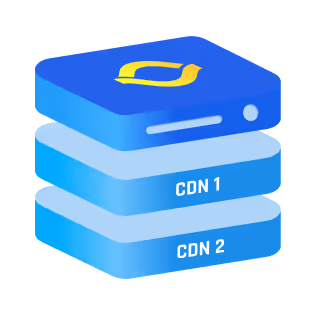As websites and online applications evolve, becoming more intricate and data-intensive, swift and seamless content access for global users becomes integral. The internet demands content availability and rapid delivery, ensuring users get real-time updates and the freshest version of any online resource.
One of the core mechanisms facilitating this is the Content Delivery Network (CDN) and its critical practice of purging the cache. This article deeply explains this practice, emphasizing its essence in the dynamic web ecosystem.
What is Purge CDN Cache?
A Content Delivery Network, or CDN, acts like a bridge connecting your website's content and the end user. The CDN stores copies of your website's content through its globally distributed servers, known as edge servers. This approach ensures that when a user from, let's say, Paris wishes to access a website hosted in New York, they retrieve the content from a server closer to them in Europe rather than directly from New York. This is what we refer to as caching: storing copies of content closer to where it's needed.
However, digital content is not static. Website operators regularly update their web content, whether it's a new blog post, an updated product image, or a necessary software patch. But if a CDN has already cached an older version of this content, users might still see the outdated information even after an update. This is where the need to "purge" or clear out the CDN cache arises.
Purging the CDN cache essentially means instructing those edge servers to discard the old, cached content. By doing this, the next time a user tries to access that particular content, the edge server will fetch the latest version directly from the primary server, ensuring the user sees the most up-to-date information.
Imagine it like clearing out old groceries from your fridge to make space for fresh ones. The old groceries are the outdated content, the fridge is the CDN, and the fresh groceries are the updated content. By purging the CDN cache, you ensure users (or, in this analogy, anyone accessing the fridge) only get the freshest, most recent content.
{{cool-component}}
How Does Caching Work?
When you're online, speed is everything. You don’t want to wait forever for a website to load. This is where caching comes into play. It’s like a digital shortcut that makes everything run faster.
Think of caching as a memory system for the web. Just like how your brain remembers facts so you don't have to look them up every time, caching keeps a quick copy of web data so it can be pulled up instantly.
Edge Servers & TTL
CDNs have special servers called 'edge servers' all over the world. These servers keep copies of web data. So, instead of your computer asking for data from a far-away place, it just gets it from the closest edge server. It’s a bit like having many mini-stores in a city instead of one big store. You can get what you need from the nearest one quickly.
Caches don’t last forever. They have a “use by” date called Time-to-Live (TTL). After this time, the data is either removed or replaced with a newer version.
Rules of Caching
Caching isn't just random. There are rules. These rules decide what data to keep, when to get fresh data, and when to remove old data. It’s like a store manager deciding which products to stock, which to reorder, and which to clear out.
When Should You Purge a CDN Cache?
- Critical content changes – price updates, launch-day hero images, or compliance edits.
- Bug or typo fixes – corrected JS bundles, swapped screenshots, patched binaries.
- Security updates – WAF rules, headers, or libraries that must roll out now.
- A/B or feature-flag rollouts – ensure the right cohort sees the intended variant.
- Marketing campaigns – synchronize global creatives and avoid regional mismatches.
Schedule routine purges during low-traffic windows, and reserve instant purges for true emergencies.
Soft Purge, Stale-While-Revalidate, and Instant Purge
There are different kinds of purging methodologies; they’re not supposed to be interchangeable:
Benefits of Purge CDN Cache
Caching helps websites load faster by storing copies of content in different places around the world. But what happens when that content changes or needs an update?
This is where "purging" comes in. Here are the clear benefits of purging a CDN cache:
1. Fresh Content:
Websites often get updates. Whether it's a new blog post, a price change, or a new product image, things change. Keeping content fresh and up-to-date can positively influence the cache hit ratio, as users are consistently accessing the most recent data, which is likely to be cached.
Purging ensures everyone sees the latest content. So, if a business launches a new product or a news site posts a breaking story, purging makes sure everyone gets this new information instantly.
2. Error Fixes:
Sometimes, websites might have mistakes like typos, broken links, or wrong images.
By purging the cache, these mistakes can be corrected swiftly. This means users won't see these errors for long, leading to a more professional appearance and less confusion.
3. Consistency Across the Globe:
CDNs have servers everywhere, from New York to Tokyo.
Purging guarantees that a user in Japan and a user in the USA see the exact same content. This consistent experience builds trust and ensures brand messaging is uniform everywhere.
4. Better User Experience:
Old promotions, outdated news, or last season's products can confuse or frustrate users.
Purging keeps everything relevant. Users won’t waste time on outdated offers or old news. They get the best, most relevant experience possible.
5. Space Management:
Just like a phone or computer can get filled with old photos or apps, CDN servers can also get filled with old data.
Purging removes unnecessary old data. This helps the system run efficiently and ensures there's always space for new, important content.
6. Enhanced Security:
Cyber threats are real. Sometimes, websites need updates to be more secure.
When security updates are made, purging the cache spreads these protections quickly. This way, every user is shielded from potential threats, and the website remains trustworthy.
{{cool-component}}
Balancing TTL and Purge for Optimal Performance
While the TTL (Time-to-Live) value plays a crucial role in determining how long content stays cached, there's a balance to strike. A low TTL would mean that the content gets checked and refreshed frequently.
This frequent checking can lead to increased loads on the origin server as the edge servers recurrently verify the content's validity. Such behavior can inadvertently slow down content delivery, especially if the origin server is under heavy load or experiencing delays.
On the other hand, utilizing the purge function effectively allows content to remain in the cache for a longer duration without the need for frequent revalidations.
By purging selectively when updates occur, the CDN can serve content swiftly from the cache, ensuring high performance and low latency for the end users. This method reduces the unnecessary burden on the origin server and offers a faster and more consistent user experience.
Conclusion
To sum it all up, the internet is in perpetual motion, continually evolving and adapting. To cater to this dynamic environment, CDNs serve as the backbone, ensuring prompt content delivery worldwide. However, the cache mechanism, though profoundly efficient, needs regular housekeeping. Purging a CDN cache is analogous to this housekeeping, ensuring the relevancy, accuracy, and safety of content.
FAQs
What is the difference between cache expiration (TTL) and manual cache purging?
TTL lets objects expire naturally after a set time, while a CDN cache purge is a manual or automated command that removes or marks content immediately. Purging overrides TTL, forcing edge nodes to fetch the newest version on the very next request.
What are the main methods of purging CDN cache?
Common options include URL purging, wildcard or directory purging, tag/key purging, and full account-wide invalidations. You can trigger each via dashboard, API, or CI/CD hooks; making cdn purge cache actions easy to automate during deploys.
How does cache invalidation differ from explicit cache purging?
Invalidation merely marks objects as stale; they remain available until replaced (soft purge). Explicit purging cache removes the data outright. Invalidation minimizes origin hits, whereas purging guarantees no stale bytes are ever served again.
How does purging the CDN cache ensure fresh and up-to-date content for users?
By deleting or invalidating outdated assets, edge servers must retrieve the latest files from the origin on the next request. This guarantees every visitor sees the current version; new prices, patched scripts, or updated copy; without waiting for TTL to expire.
What are the security benefits of purging CDN cache after applying updates or patches?
Immediate purges push critical fixes (e.g., XSS sanitization, CSP headers, vulnerable JavaScript) to every PoP. This closes attack windows, prevents exploitation of cached assets, and ensures threat actors can’t retrieve obsolete, insecure versions from edge nodes.



.png)
.png)
.png)






